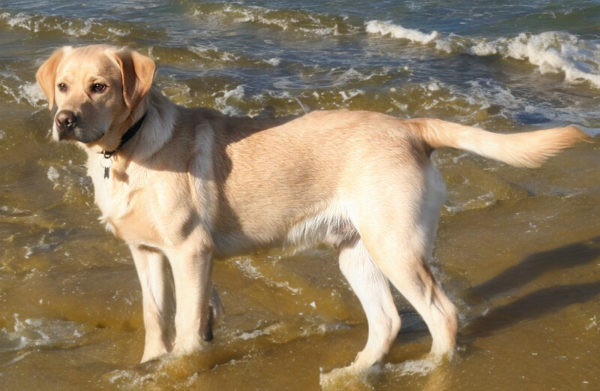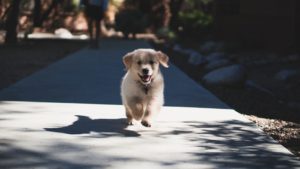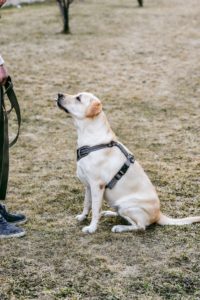
This highly fashionable dog was originally bred to retrieve codfish in the icy waters of Newfoundland. Originating from Canada, the Labrador made its appearance in Great Britain in the early 19th century. It caught the attention of aristocrats in Dorset County, located in the southwest of the country, who trained it for game retrieving.
Description
- Medium-sized dog, sturdy and well-built.
- Broad head with drooping ears.
- Powerful jaws.
- Wide and well-descended chest.
- Short, dense, and waterproof coat.
- Height at the withers: 56 to 57 cm for males; 55 cm for females.
- Weight: 25 to 35 kg.
- Average lifespan: 12 years
Distant origins
The true origins of the Labrador remain shrouded in mystery. Though it hails from Canada, some speculate that its ancestors might have Nordic roots, possibly brought by the Viking explorer, Eric the Red, when he landed in North America in the late 5th century. What is certain is that by the 16th century, the Labrador spent a considerable time in Newfoundland, where it interbred with the native Newfoundland dogs and “St. John’s dogs,” the island’s original canine inhabitants. In this harsh land, the Labrador developed exceptional resilience and a strong affinity for water. It became a valuable asset for cod fishermen, skilled at retrieving fish that escaped their nets.
Near extinction
At the end of the 18th century, the Newfoundland administration decided to restrict the number of dogs on the island due to their interference with sheep farming. In 1780, Governor Edwards prohibited households from owning multiple canines, and in 1815, as the rule was not being enforced, a decree was issued to eliminate any unmuzzled dog. As a result, many inhabitants had to part ways with their beloved companions.
Crossing the Atlantic
The luckier Labradors crossed the Atlantic to England aboard British fishing vessels. There, they caught the attention of breeders in Dorset County. Through the influence of the Pointer, their appearance was refined, and they were trained for hunting. Their innate retrieving abilities played a pivotal role. The Labrador quickly gained fame throughout the country, eventually receiving official recognition as a breed in 1903.
Physical characteristics
- General characteristics: A robust and enduring dog, well-suited for various tasks
- Head: The skull is broad with a pronounced stop, giving the head an aesthetically pleasing appearance. The eyes are warm and friendly, neither too large nor too small, and come in brown or hazel colors
- Ears: Well-balanced in size and weight, they hang close to the head and are positioned towards the back
- Muzzle: The jaws are of medium size but exceptionally powerful. The wide nose has two distinct and well-developed nostrils. The strong teeth meet in a scissor-like bite, with the upper incisors overlapping the lower ones snugly
- Neck: Strongly defined and powerfully set between the shoulders
- Body: The chest is broad and well-descended, creating a level top-line. The loins are wide, short, and sturdy
- Limbs: The forelegs possess strong and even bone structure, straight from the elbows to the ground, regardless of the angle. The shoulders are long and sloping, while the hindquarters are well-developed, and the croup maintains a steady line without descending towards the tail. Both the front and rear assembly exhibit well-defined muscles
- Feet: The feet are round and compact, with well-arched toes and well-developed pads
- Tail: The tail is of moderate length, starting off thick at the base and tapering towards the tip. There are no fringes, and the entire tail is covered with short, tight fur, creating a slightly rounded appearance often referred to as the “otter tail.”
- Coat: The breed’s coat is a magnificent feature, short and dense without any waves, fringes, or curls. It feels coarse to the touch but is not irritating. The undercoat serves as an impermeable barrier
- Color: The coat is solid in black, yellow, or brown. In the case of yellow, it may vary from fox-red to cream. A small white spot on the chest is permissible
A beloved companion to both young and old, this gentle dog is equally at home in the city and the countryside
Temper
Positive traits
- Intelligent
- Obedient
- Overflowing with affection
- Extremely sociable
- Loyal
- Quiet (Only barks when necessary)
Negative traits
- Can be a bit impulsive
Chic and rugged, a dog filled with qualities
The Labrador can do it all, and with style! This gifted breed is soaring in popularity worldwide, rightfully maintaining its position among the top breeds in France, Great Britain, Australia, and the United States.
Once you experience the company of a Labrador, you’ll never want to part ways with it! It’s no surprise that they are employed in drug enforcement and counterterrorism operations (detecting weapons and explosives) and serve as excellent guide dogs for the visually impaired. Easy to train, they quickly grasp commands, eagerly anticipating what is expected of them.
A true gem
Labradors swiftly acquire the fundamentals of canine etiquette. They never bite a stranger’s hand reaching out for a pat, get along charmingly with their fellow canines, and go the extra mile to please those around them.
A welcoming host
Expecting guests? This friendly companion enthusiastically welcomes parents, friends, the mail carrier, or even the butcher, wagging its tail with excitement. And what a memory! It recognizes everyone, even individuals it rarely encounters. The Labrador Retriever has a wonderful temperament. It is an exemplary companion, neither aggressive nor timid.
A decent watchdog
Despite being good-natured, can the Labrador still protect the house? Yes, indeed. It has a strong sense of territoriality and will bark relentlessly if a stranger approaches the gate. Its size, powerful jaws, and booming voice are usually enough to deter thieves. However, it’s not a guard dog as it lacks aggression; don’t attempt to train it for attack, as it’s not its style.
Excellent with ducks
When it comes to hunting, the Labrador has an excellent sense of smell and remarkable observational skills. Being a retriever, it can locate where the game has fallen. Upon command from its owner, the Labrador Retriever retrieves ducks in the order they were shot. Check it out: not a single one is missing! It displays a lot of endurance and courage, fearlessly diving into cold water amidst dense reeds or crossing a river. Thanks to its strong jaws and powerful neck, it can carry large game pieces while keeping them above the waterline. It is effective not only in marshes but also in plains and woods, where it can retrieve small game.
A turbulent youth
While this exceptional dog can learn anything, it is essential to be firm with it, especially during its early months. Because of its spirited nature, our young friend might get up to some mischief. For example, it may jump into the water and start pulling an inflatable boat without seeking the occupants’ approval or bound up to visitors, leaving its big, dirty paws on their clothes. A word of caution, despite the Labrador’s innate love for water, exercising some caution is wise. For instance, a 2-year-old Labrador that has never been introduced to water and is suddenly pushed into it may not appreciate the experience. Young males can be stubborn or even headstrong. Proper training is essential for this lively and spirited puppy!
From its earliest days, this teddy bear loves playing with sticks.
Dislikes being alone
Being a stabilizing factor within the family, the Labrador dislikes being left alone too often and being treated indifferently or unfairly. If left to its own devices, unloved, or mistreated, this seemingly problem-free dog may become destructive. That’s its way of seeking revenge!
 Early development
Early development
At 6 months, the Labrador comprehends everything, and by 8 or 10 months, if trained for hunting, it should excel at its tasks. At home, it knows what is allowed.
This breed boasts robust health and an insatiable appetite! Its only minor issue? The tendency to gain weight.
Daily routine
- Voracious eater
- Requires a minimum of three substantial walks per day
- Proficient swimmer and diver
- Occasional tendency to wander off
- Generally clean indoors
- Respectful of the garden
- Well-behaved in the car
- Sensitive to heat
- Enjoys open spaces as well as urban living
- Its wet fur dries within minutes
 Wanderer?
Wanderer?
Not necessarily. However, being a hunting dog, Labradors, more than other canines, may have a tendency to escape to pursue game or potential mates. Young males are particularly prone to running away and often follow the same routes. Try to identify these routes and secure your garden – it’s the only solution!
In terms of practical living, a Labrador is ideal. It is clean, requires no specific grooming or medical treatments, walks calmly on a leash, and doesn’t pull. But be cautious and secure your kitchen cupboards, as this breed has a hearty appetite.
Diet
Labradors always seem hungry and have a tendency to gain weight. They should be fed twice a day at fixed times. Avoid encouraging constant begging and sternly reprimand if they try to steal food. Treats and table scraps are strictly forbidden. If your companion remains overweight despite your efforts, it’s time to put it on a diet. Your veterinarian can recommend a “light” diet tailored to its needs.
Living space
While Labradors adapt well to city life and can live in apartments with a minimum of three real walks per day (not just quick bathroom breaks), they much prefer a home with a garden. The dream, of course, is the countryside with nearby ponds where this champion swimmer can indulge in its favorite game of diving, swimming, and retrieving the sticks thrown by its owner.
Health
Labradors are known for their robust and sturdy health. However, as they age (starting around ten years), watch out for arthritis problems and heart issues, as they are hardworking and give their all. Like in many popular breeds, there may be some hereditary conditions, although they are rare. Hip dysplasia, for example… In the United States and England, some individuals become blind due to progressive retinal atrophy, but this problem affects very few dogs in France.
Grooming
Labradors require minimal grooming costs. Regular brushing is sufficient to maintain their slightly coarse coat. For a shiny coat, a judicious addition of brewer’s yeast and sunflower oil can work wonders. And don’t forget, Labradors are natural swimmers, so don’t deprive them of their favorite activity.
 Can your labrador retriever walk without a leash?
Can your labrador retriever walk without a leash?
Yes, if it’s not prone to wandering, has received proper training, and stays close to your side (“heel” command). A Labrador can even accompany you on bike rides (on isolated roads) or during your jogging sessions.

 From its earliest days, this teddy bear loves playing with sticks.
From its earliest days, this teddy bear loves playing with sticks. Early development
Early development Wanderer?
Wanderer? Can your labrador retriever walk without a leash?
Can your labrador retriever walk without a leash?